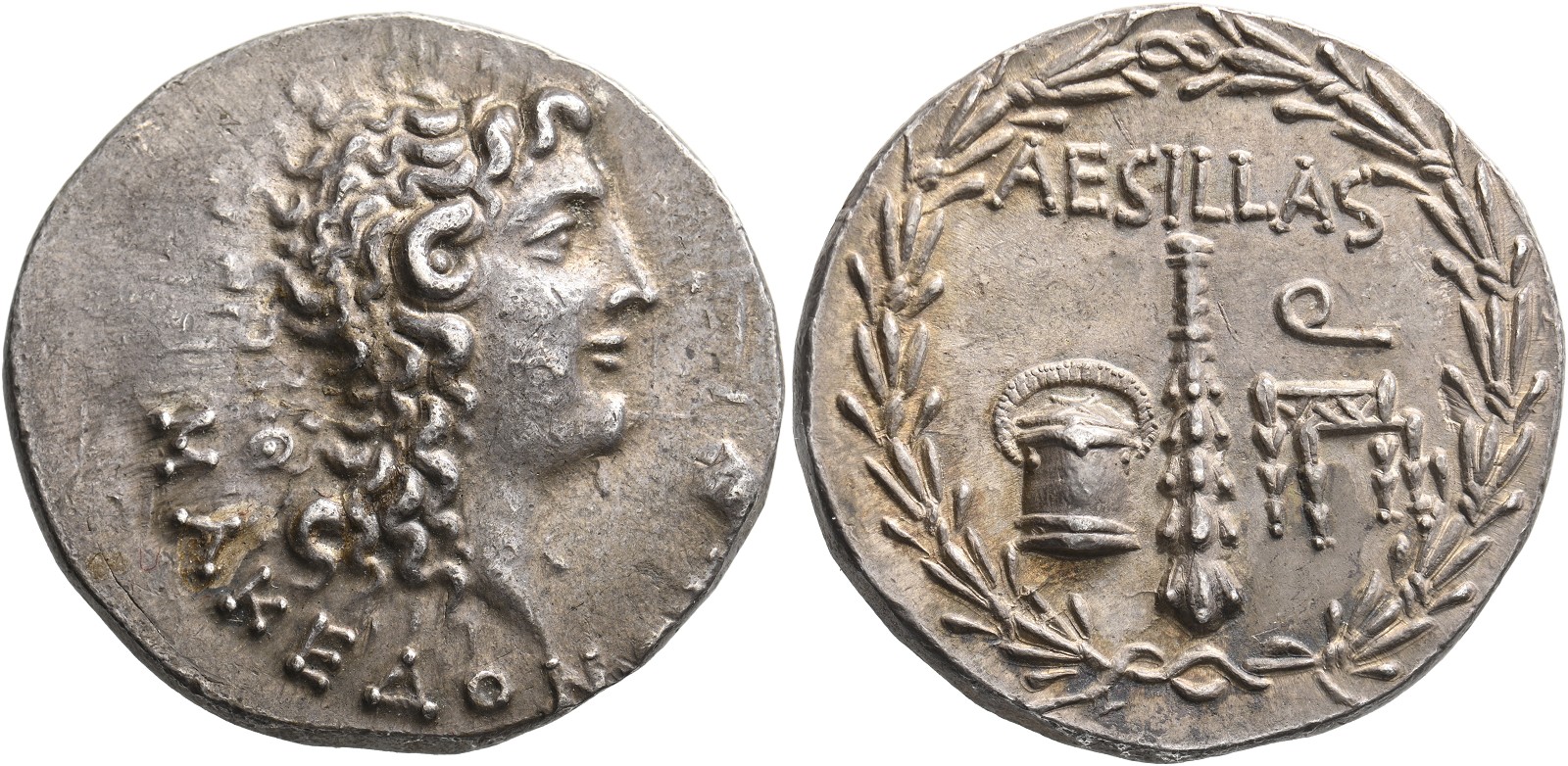85 BCE - 60 BCE | ΗΡΑΚΛΕΟΥΣ / ΣΩΤΗΡΟΣ / ΘAΣIΩN
Overstriking coin
Thasos on Aesillas - Gorny.jpeg
[1]
Overstruck variety
2281 - Maroneia (tetradrachm) over Aesillas (Münzen.jpeg
|
|
Sale(s)Sale(s) ᵖ:
|
Gorny & Mosch, 160, 9 oct. 2007, 1032 = Lanz, Nov. 2004, 160 = Lanz, 135, 21 May 2005, 139 = Künker, 366, 2022, 6752 = Künker, EA 78, 17 July 2023, 5029
|
| Private collection(s)Private collection(s) ᵖ:
|
Sammlung Christian Flesche
|
|
Description
| ObverseInscription or printing placed on the obverse.:
|
Head of youthful Dionysos to right, wearing ivy wreath
|
ReverseInscription or printing placed on the reverse.:
|
ΗΡΑΚΛΕΟΥΣ / ΣΩΤΗΡΟΣ / ΘAΣIΩN (Greek) Herakles standing left, nude but for lion's skin over his shoulder and left arm, resting right hand on club, in the inner left field, monogram
|
Mint and issuing power
| MintIdentifies the place of manufacture or issue of a numismatic object.:
|
Thasos
|
Ancient regionAncient region.
|
Thrace
|
Modern countryModern country: Greece
|
AuthorityIdentifies the issuing power. The authority can be "pretended" when the name or the portrait of X is on the coin but he/she was not the issuing power. It can also be "uncertain" when there is no mention of X on the coin but he/she was the issuing power according to the historical sources:
|
Roman Republic
|
Chronology
| FromIdentifies the initial date in a range assigned in a numismatic context. 85 BCE toIdentifies the final date in a range assigned in a numismatic context.. 60 BCE
|
Hellenistic 323-30 BC  periodTime period of the numismatic object. periodTime period of the numismatic object.
|
Physical description
MetalThe physical material (usually metal) from which an object is made.: Silver 
|
WeightWeight of the numismatic object (in grams). in grams: 16.5916.59 g <br />16,590 mg <br />
|
DenominationTerm indicating the value of a numismatic object. Examples: tetradrachm, chalkous, denarius.: tetradrachm 
|
|
|
|
StandardStandard.: Attic
|
References
Description
| ObverseInscription or printing placed on the obverse.:
|
MAKEΔONΩN (Greek) Head of the deified Alexander the Great right
|
ReverseInscription or printing placed on the reverse.:
|
AESILLAS (Latin) Q Money chest, club, and chair, all within laurel wreath
|
Mint and issuing power
Chronology
| FromIdentifies the initial date in a range assigned in a numismatic context. 95 BCE toIdentifies the final date in a range assigned in a numismatic context.. 65 BCE
|
Hellenistic 323-30 BC  periodTime period of the numismatic object. periodTime period of the numismatic object.
|
Physical description
| DenominationTerm indicating the value of a numismatic object. Examples: tetradrachm, chalkous, denarius. ᵖ:
|
tetradrachm 
|
StandardStandard. ᵖ:
|
Attic
|
References
References
- ^ Prokopov, Ilya (2006), Die Silberprägung der Insel Thasos und die Tetradrachmen des "thasischen Typs" vom 2.-1. Jahrhundert v. Chr., Griechisches Münzwerk, Berlin, 342 p., 118 p. of plates
- ^ Callataÿ, François de (2012), “A Thasian type tetradrachm with the legend ΘΡΑΚΩΝ overstruck on an Athenian stephanephoros tetradrachm of ΑΠΕΛΛΙΚΩΝ ΓΟΡΓΙΑΣ (88/87 BC) and its consequences for the Thasian-type coinage”, in E. Paunov and S. Filipova (eds.), ΗΡΑΚΛΕΟΥΣ ΣΩΤΗΡΟΣ ΘΑΣΙΩΝ. Studia in honorem Iliae Prokopov sexagenario ab amicis et discipulis dedicata, Veliko Tarnovo, Faber Publ., p. 307-321.
- ^ MacDonald, David (2012), "ΗΡΑΚΛΕΟΥΣ ΣΩΤΗΡΟΣ ΘΡΑΚΩΝ tetradrachms die links and dating," in Evgeni Paunov (ed.), ΗΡΑΚΛΕΟΥΣ ΣΩΤΗΡΟΣ ΘΑΣΙΩΝ. Studia in honorem Iliae Prokopov sexagenario ab amicis et discipulis dedicata, Veloko Tarnovo, p. 323-339.
- ^ Callataÿ, François de (2021), “On pattern and purpose of overstrikes of late Hellenistic tetradrachms in Thrace Macedonia”, in Ulrike Peter and Bernhard Weisser (eds.), Thrace. Local coinage and regional identity, Berlin Studies of the Ancient World 77, Berlin, Topoi, p. 263-289.
- ^ Callataÿ, François de (1996), "Les monnaies au nom d'Aesillas", in T. Hackens (ed.), Italiam Fato Profugi Hesperinaque Venerunt Litora. Numismatic Studies Dedicated to Vladimir and Elvira Eliza Clain-Stefanelli, Numismatica Lovaniensia 12, Louvain-la-Neuve, p. 113-151.
- ^ Bauslaugh, Robert A. (2000), Silver coinage with the types of Aesillas the Quaestor, Numismatic Studies 22, New York.


